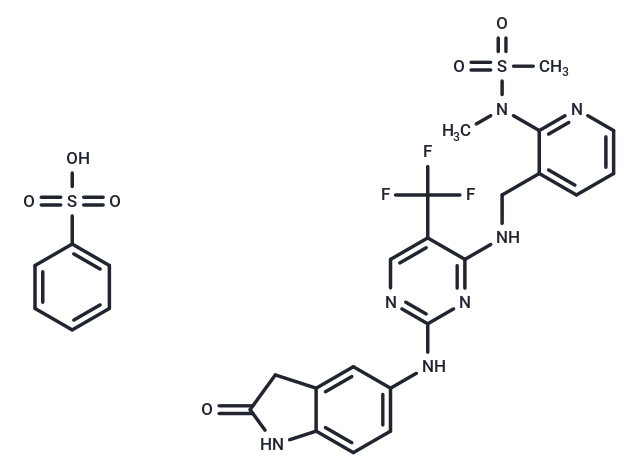Shopping Cart
- Remove All
 Your shopping cart is currently empty
Your shopping cart is currently empty

PF-562271 besylate (PF-00562271 Besylate) is a potent, ATP-competitive, reversible inhibitor of FAK with IC50 of 1.5 nM, ~10-fold less potent for Pyk2 than FAK and >100-fold selectivity against other protein kinases, except for some CDKs.

| Pack Size | Price | Availability | Quantity |
|---|---|---|---|
| 1 mg | $32 | In Stock | |
| 5 mg | $72 | In Stock | |
| 10 mg | $90 | In Stock | |
| 25 mg | $148 | In Stock | |
| 50 mg | $221 | In Stock | |
| 100 mg | $329 | In Stock | |
| 200 mg | $475 | In Stock | |
| 1 mL x 10 mM (in DMSO) | $96 | In Stock |
| Description | PF-562271 besylate (PF-00562271 Besylate) is a potent, ATP-competitive, reversible inhibitor of FAK with IC50 of 1.5 nM, ~10-fold less potent for Pyk2 than FAK and >100-fold selectivity against other protein kinases, except for some CDKs. |
| Targets&IC50 | FAK:1.5 nM |
| In vitro | PF-562271 shows the selective inhibitory effects on FAK and Pyk2 tyrosine kinase activity with IC50 of 1.5 nM and 14 nM, respectively. And in cell-based assays, the IC50 of PF-562271 is shown to be 5 nM for FAK, which is more selective compared to other kinase targets. [1] In 2 dimensional (2D) cultures, PF-562271 results in a dose-dependent cell proliferation inhibition in FAK WT, FAK?/? and FAK kinase-deficient (KD) cells with IC50 of 3.3 μM, 2.08 μM and 2.01 μM, respectively. [2] |
| In vivo | In several human s.c. xenograft models, PF-562271 exhibits dose-dependent tumor growth inhibition, and produces maximum tumor inhibition for PC-3M, BT474, BxPc3, and LoVo ranging from 78% to 94% inhibition at doses of 25 to 50 mg/kg twice daily, without weight loss, morbidity, or death. [1] PF-562271 (25 mg/kg by p.o.) leads to a significant decrease in tumor progression in both subcutaneous and bone metastasis PC3M-luc-C6 xenograft models. [3] In a Huh7.5 hepatocellular carcinoma xenograft model, combination therapy of sunitinib and PF-562271 targets angiogenesis and tumor aggressiveness, and produces more significant anti-tumor effect than single agent by blocking tumor growth and impacting the ability of the tumor to recover upon withdrawal of the therapy. [4] |
| Kinase Assay | Recombinant kinase assay and enzyme kinetics : Briefly, purified-activated FAK kinase domain (amino acid 410–689) is reacted with 50 μM ATP and 10 μg per well of a random peptide polymer of Glu and Tyr, p(Glu/Tyr), in kinase buffer [50 mM HEPES (pH 7.5), 125 mM NaCl, and 48 mM MgCl2] for 15 minutes. Phosphorylation of p(Glu/Tyr) is challenged with serially diluted PF-562271 at 1/2-Log concentrations starting at a top concentration of 1 μM. Each concentration is tested in triplicate. Phosphorylation of p(Glu/Tyr) is detected with a general antiphospho-tyrosine (PY20) antibody followed by horseradish peroxidase (HRP)-conjugated goat anti-mouse IgG antibody. HRP substrate is added, and absorbance readings at 450 nm are obtained after addition of stop solution (2 M H2SO4). IC50 values are determined using the Hill-Slope Model. Broad kinase selectivity profiling is performed in house and by using the KinaseProfiler Selectivity Screening Service available through UpState Biotechnology. |
| Cell Research | Cells are plated for 48 hours before addition of PF-562271. After 3 days cells are fixed by addition of ice cold 25% trichloroacetic acid (TCA) solution prior to staining with Sulforhodamine B (SRB) dye solution. Plates are washed with 1% glacial acetic acid, air-dried and resuspended in 10 mM Tris buffer, pH 10.5 before reading absorbance at 540 nm. Curve fitting and generation of IC50 values is carried out using GraphPad Prism 4 software from six replicates.(Only for Reference) |
| Alias | PF-00562271 Besylate |
| Molecular Weight | 665.66 |
| Formula | C21H20F3N7O3S·C6H6O3S |
| Cas No. | 939791-38-5 |
| Smiles | OS(=O)(=O)c1ccccc1.CN(c1ncccc1CNc1nc(Nc2ccc3NC(=O)Cc3c2)ncc1C(F)(F)F)S(C)(=O)=O |
| Relative Density. | no data available |
| Storage | Powder: -20°C for 3 years | In solvent: -80°C for 1 year | Shipping with blue ice. | ||||||||||||||||||||||||||||||
| Solubility Information | H2O: < 1 mg/mL (insoluble or slightly soluble) Ethanol: < 1 mg/mL (insoluble or slightly soluble) DMSO: 55 mg/mL (82.62 mM), Sonication is recommended. | ||||||||||||||||||||||||||||||
Solution Preparation Table | |||||||||||||||||||||||||||||||
DMSO
| |||||||||||||||||||||||||||||||

Copyright © 2015-2024 TargetMol Chemicals Inc. All Rights Reserved.